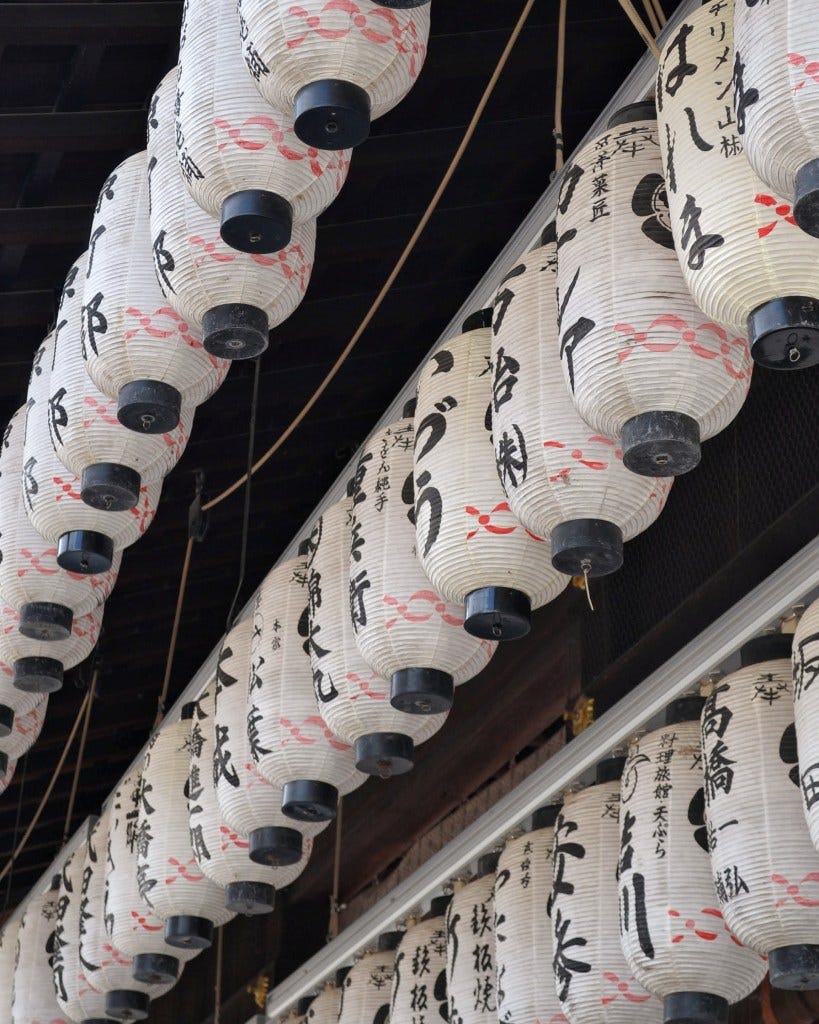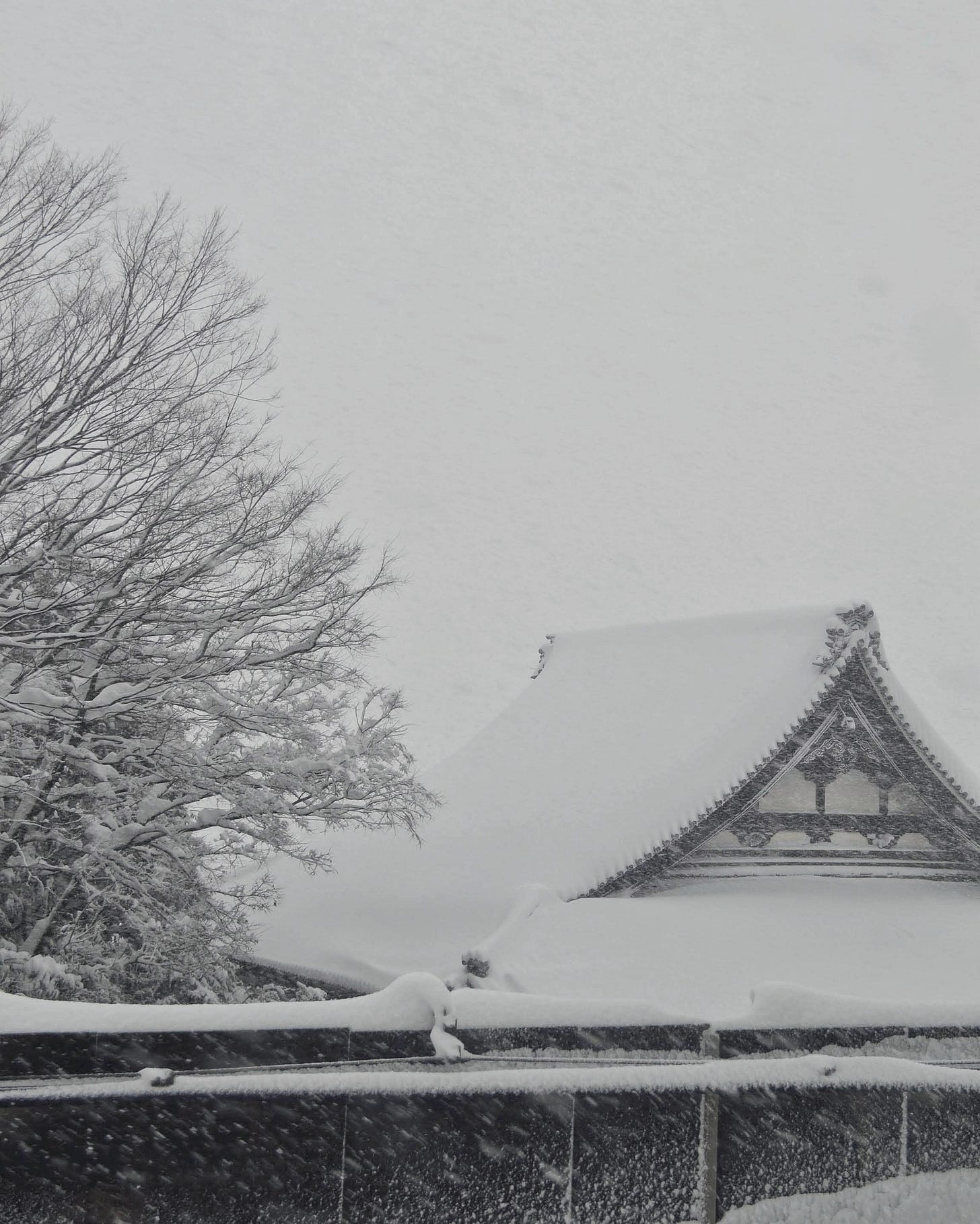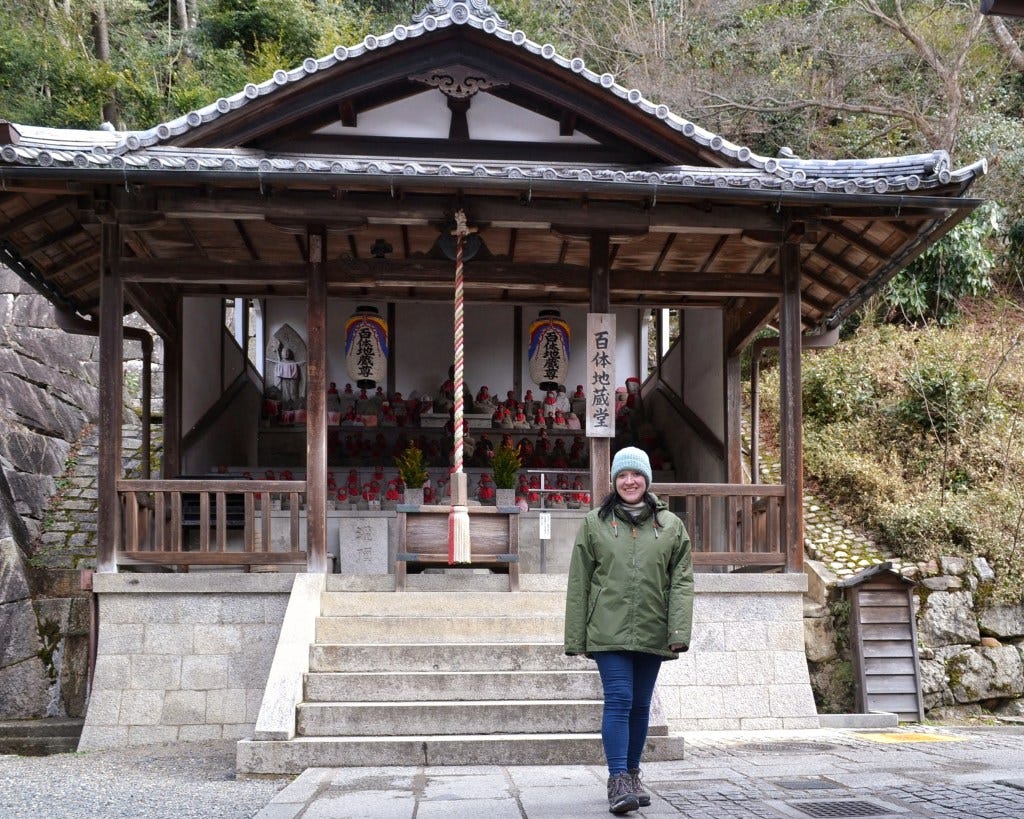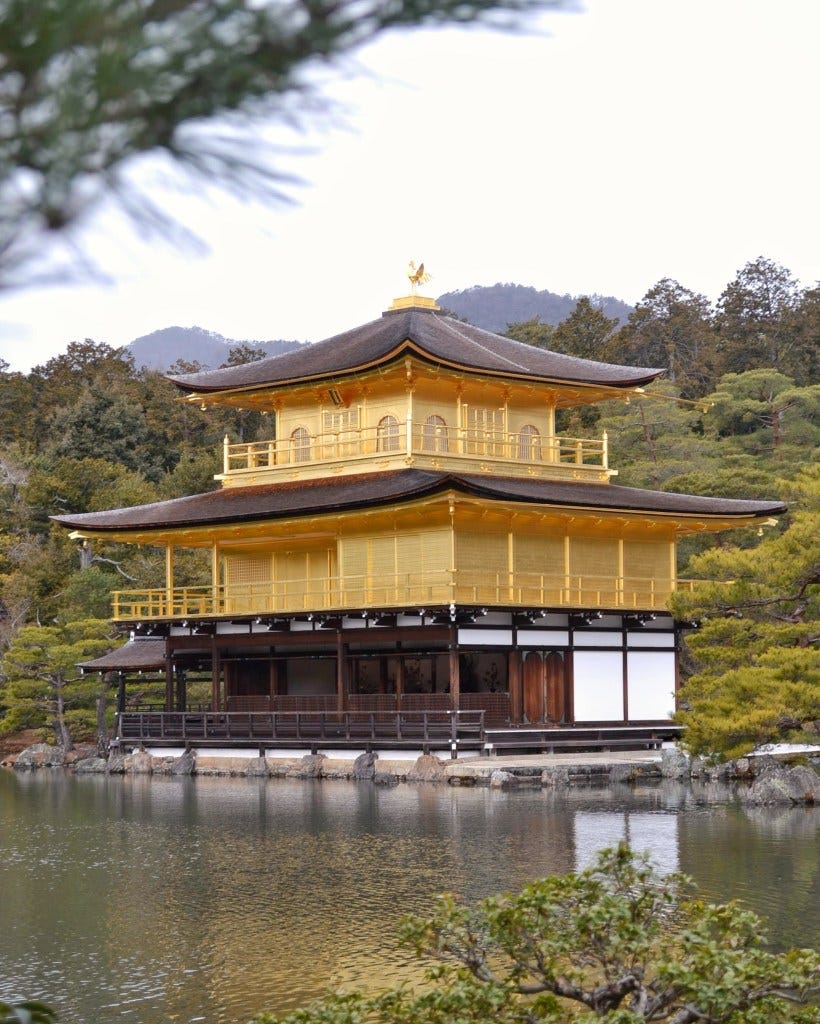Four Days in Kyoto, Japan
a love letter to japan's ancient capital
*POST UPDATED NOVEMBER 2025.
Hello friends! Happy weekend! It is my absolute pleasure to be bringing you a brand new + sparkly city guide: Four Days in Kyoto, Japan! In case you missed it, Husband and I went on honeymoon to Japan in January and spent two glorious weeks slowly making our way around the country! We hit Tokyo first, kickstarting the trip with four days in Shinjuku and a morning in Asakusa, followed by four days in Kyoto, another four days in Osaka, and then one final day back in Tokyo, this time in Shibuya. As the title above might have hinted at, this post will deal with all things Kyoto, and I am so excited to share some of the city’s magic with you!
Firstly, let’s get this out in the open: Kyoto was our favourite city in Japan. We loved everything about it. The calmness of the city, the people, the beautiful temples on every street corner, the food, every! single! thing! On our first night, after checking into our gorgeous hotel and stepping out for a wander, I’d say it took us a whole 2-minutes to fall head-over-heels IN LOVE with the place. There’s such a mesmerizing feeling of magic and beauty in the air
Also, just to prepare you: this is different to every travel guide I’ve ever written. Normally I’d share a complete overview, covering everything from hotels to foodie spots to the best places to tourist etc. However, not today! Today’s post will deal exclusively with everywhere we tourist-ed in Kyoto, while a separate food + drink guide will follow shortly. To be honest, I just had too many recommendations for one post and didn’t want to overwhelm you! Hopefully this method of divvying up the two is the solution 🙂
kyoto fun facts
Everybody’s favourite section! Read, memorize, and go wow people with your newfound cultural smarts!
way back when – like waaaaay back, from 794 to 1868 AD(!) – Kyoto was the capital of Japan! Tokyo, which was then known as Edo, nabbed the title when it became a major trading hub with the west.
related: the word Kyoto literally translates to “capital city”. Before it was named Kyoto, it was known as Heian-kyō, which apparently translates to “capital of peace and tranquility”. For me, the former name definitely captures the spirit of the city; there was something so overwhelmingly calming in the air!
Kyoto’s nickname is the City of Ten Thousand Shrines. While that’s a sliiiight exaggeration – the real number rests in and around 3,000 – there sure are a whole load of shrines and temples in the city.
originally, Kyoto was one of the intended cities for the USA’s atomic bomb drops. Thankfully, the city was spared that horrific fate – but the reason why is disputed. According to some, US Secretary of War Henry Stimson, who honeymooned in Kyoto(!), asked President Truman himself to remove it from the target lists due to his great admiration of the city. However, others argue that it was archaeologist and art historian Langdon Warner that went to Truman, citing the cultural assets of Kyoto as the reason to spare it. As an archaeology & art historian major myself, I’m definitely leaning towards the latter.
Kyoto has 17 UNESCO World Heritage Sites! Rather than being listed separately, the spots are listed together as ‘Historic Monuments of Ancient Kyoto (Kyoto, Uji, and Otsu Cities)’. For a more detailed breakdown of the list, click here.
PS, don’t worry! There are a few more location-specific fun facts littered throughout the rest of this post 😉
getting there
we arrived into Kyoto on a Shinkansen bullet train from Tokyo Station. It cost us ¥13,970 each, and was expected to take1 2-hours and 14-minutes. Full and exact details about that part of our journey can be found here.
our Shinkansen delivered us to Kyoto Station. From there, we took the Karasuma Line subway to Shijō Station. This cost us ¥220 each and took a very speedy 3-minutes!
from Shijō Station, we walked the very convenient 4-minutes to our hotel, below.
where we stayed
THE GENERAL KYOTO Bukkoji Shinmachi // our favourite hotel in Japan! Would 100% recommend. For a full recap of our wonderful stay, please see this post here.
where we tourist-ed
Now we’re down to the good stuff: where we tourist-ed! Listed below is a comprehensive list of everywhere we stopped in for a light spot of tourist-ing. To make it as easy to read as possible, each attraction has an ‘at a glace‘ section — which covers all the need-to-know info in a condensed format! — and also a more in-depth paragraph or two for those of you who are looking for more of a deep-dive.
Happy Japlanning!
fushimi inari-taisha
— AT A GLANCE
OUR RATING: 12/10
ENTRY COST: free
GENERAL INFO: website // ADDRESS: 68 Fukakusa Yabunouchicho, Fushimi Ward, Kyoto, 612-0882
GETTING THERE: Inari subway station is a 1-minute walk away. We took the Nara Line from Kyoto Station, which cost ¥150 each & took 6-minutes.


Fushimi Inari-Taisha is probably the most widely recognized Shinto shrine in all of Japan. However! This has little to do with the actual main hall of the shrine, and everything to do with the thousands of torii gates behind the shrine! Torii gates can be spotted at temples and shrines all over the country – they mark the boundary between regular and sacred spaces! – but seeing so many in such close proximity is quite a sight! In this case, the beautiful vermillion coloured torii line the path up to Mt Inari. Who was Inari? The deity of rice, harvest, and fertility.
Husband and I absolutely loved wandering among the torii, it was probably one of our favourite experiences in Kyoto! We were a little worried it would be jam-packed with influencers or Instagram tourists – which it kiiinda was – but wow, it was absolutely worth the hype! If you take one tourist attraction away from this guide, please let it be this!
Pro tip: to escape the Instagram hun-buns, just walk further up and away from the base! Most of that ilk are only in it for the photo-op and aren’t bothered actually enjoying the walk. Husband & I hiked about 45-minutes up the mountain – which I believe is near the halfway mark? the full thing takes 2ish-hours! – and there were only a handful of others up there. Having the pathway to ourselves for even a couple minutes felt beyond magical
Fun fact: there are around 10,000 torii gates climbing up the mountain side! Each and every one was donated by individuals or businesses a. in the hope of having a wish come true or b. in gratitude for a wish that actually did come true!
nijō castle
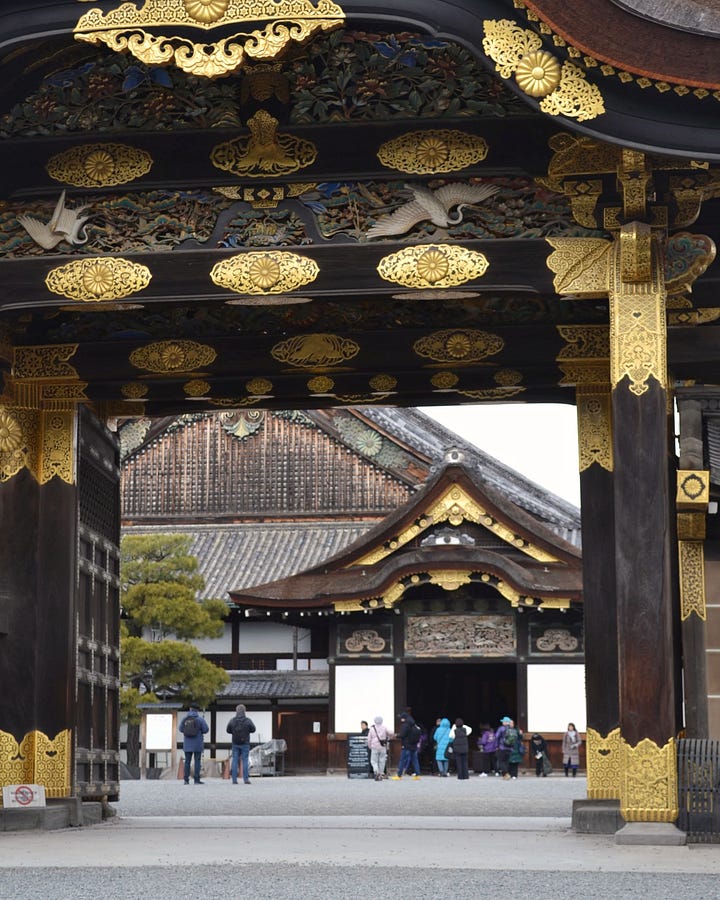

— AT A GLANCE
OUR RATING: 12/10
ENTRY COST: ¥1,300
GENERAL INFO: website // ADDRESS: 541 Nijojocho, Nakagyo Ward, Kyoto, 604-8301
GETTING THERE: Nijojo-mae bus stop is a 1-minute walk away. We walked from our hotel, which took about 20-minutes.
NEARBY FOOD STOP: CLAMP COFFEE SARASA, for the best French toast in possibly the whole country; a 10-minute walk away. Read more here!
Nijō Castle was built in the early 17th century as the Kyoto residence of Tokugawa Ieyasu, the first shōgun (aka, military leader) of the Edo period. The castle complex – which is nothing like Europe’s medieval castles, such as Vianden – is a flatland castle complex. There are two moats(!), two circles of defense, the Ninomaru Palace where the shōgun resided, the Honmaru Palace (which is closed to the public), and many beautiful gardens to stroll through, including a cherry blossom orchard, plum orchard, etc. Visitors can also climb up to the stone foundations of the former castle keep, which offers a nice view over the grounds below.
There are two ticket types at Nijō Castle: a garden only ticket, or a ticket that includes entry into the Ninomaru Palace. Husband and I opted for the latter, and I would definitely recommend this to anyone thinking of visiting! The route inside the Palace is well laid out, with many informative signs and mannequin staged scenes within. There is also some really impressive paintings on the walls & ceilings!
The highlight for us was easily the famous “nightingale corridor”! Neither Husband nor I had ever of such a thing before, and if you’re in the same boat, allow me! The wooden floors within the Ninomaru Palace were constructed in such a way that the nails underfoot would make a kind of chirping bird sound. This would then alert palace security of an intruder, so it acted as an early-day alarm of sorts! How clever is that?! It was such a cool and unusual experience!
Fun fact: Nijō Castle is one of the properties listed in Kyoto’s UNESCO World Heritage listing!
Be warned: they don’t accept card payments here, and photography is forbidden inside the Ninomaru Palace.
kiyomizu-dera temple


— AT A GLANCE
OUR RATING: 8/10
ENTRY COST: ¥400
GENERAL INFO: website // ADDRESS: 1 Chome-294 Kiyomizu, Higashiyama Ward, Kyoto, 605-0862
GETTING THERE: Gojō-zaka subway station is a 13-minute walk away. We walked from our hotel, which took about 40-minutes.
NEARBY FOOD STOP: Honke Nishio Yatsuhashi (Kiyomizu store), for incredible soft-serve ice cream; a 1-minute walk away. Read more here!
Kiyomizu-dera is a Buddhist temple located on the hillside to the east of Kyoto city. The temple – which is actually made up of many different shrines and temples within, so it’s really more of a complex! – was founded in 780 on Kyoto’s Otowa Waterfall. In fact, it’s the waterfall that gives Kiyomizu-dera its name, translating to ‘Pure Water Temple’ in English! Of the many temples in the complex, visitors can pray to a range of different deities for specific things: safe & easy childbirth, longevity, success at school, luck in love, etc.
When Husband and I visited Kiyomizu-dera, there was the lightest dusting of snow falling down around us, casting the most magical aura over the place. We enjoyed the views over the city below and took our time strolling between the different temples, paying our respects at a couple of different shrines, etc. Overall, it’s a nice spot to spend a while wandering around, but we found that it was rather touristy, which took away from the magic ever so slightly.
Fun fact: Kiyomizu-dera is another one of the properties included in Kyoto’s UNESCO World Heritage listing!
kinkaku-ji


— AT A GLANCE
OUR RATING: 8/10
ENTRY COST: ¥500
GENERAL INFO: website // ADDRESS: 1 Kinkakujicho, Kita Ward, Kyoto, 603-8361
GETTING THERE: Kinkakuji-michi bus stop is a 2-minute walk away. We took the 205 City Bus from platform B3 at Kyoto Station; it cost ¥230 each and took around 40-minutes.
Kinkaku-ji Temple – aka, the Golden Pavilion! – is a Zen Buddhist temple on the outskirts of Kyoto. The temple dates back to the 14th century, when it was built as the retirement retreat for shōgun Ashikaga Yoshimitsu. However! The temple we see today is merely a reconstruction from 1955; it has been burned down and rebuilt several times over the course of its history, most recently in 1950 by a crazed monk. It is famous because the top two floors of the building are covered completely in gold leaf!
While we found Kinkaku-ji to be undeniably beautiful and such an impressive sight to see, the huge mass of visitors kind of put us off the place? It was easily the busiest attraction we visited in Kyoto, but also probably the one we spent the least time at. Selfie-taking tourists aside; the temple isn’t actually open to visitors, so once you’ve had a gawp and wandered through the garden at the back, that’s really all there is to it. We’re glad we got to see it with our own two eyes, but it definitely wasn’t the highlight of our time in Kyoto.
Fun fact: you guessed it! Kinkaku-ji Temple is another of the properties included in the UNESCO World Heritage listing!
nishiki market
— AT A GLANCE
OUR RATING: 9/10
ENTRY COST: free
GENERAL INFO: website // ADDRESS: Nakagyo Ward, Kyoto, 604-8055
GETTING THERE: Shijo Takakura bus stop is a 3-minute walk away. We walked from our hotel, which took about 12-minutes.
NEARBY FOOD STOP: Taqueria Tacos is literally right outside the market, a 1-minute walk away, and they serve some of the best tacos we’ve ever had. Read more here!
Nishiki Market, also known as ‘Kyoto’s Kitchen’, is a long covered marketplace with more than 100 little shops and restaurants nestled within. The spots largely deal in food-related items, but we also stumbled across a handful of stores selling traditional Japanese wares and souvenirs.
We ate at a couple different spots in Nishiki – THE CITY BAKERY and Nishiki Gyoza – but I’ll be sharing more about that in my upcoming Kyoto foodie guide. We also made one non-foodie purchase at a the market: traditional Japanese tabi socks! A lovely lady shop-owner drew us in and we literally couldn’t resist how adorable some of the sock designs were – we left with six different pairs!
Fun fact: Nishiki Market runs along five whole blocks!
gion & higashiyama districts


— AT A GLANCE
OUR RATING: 6/10
ENTRY COST: free
GENERAL INFO: website // ADDRESS: Higashiyama Ward, Kyoto, Japan
GETTING THERE: Gion bus stop is a 2-minute walk from the central area. We walked from our hotel, which took about 25-minutes.
NEARBY FOOD STOP: Ramen Miyako (Gion Main Shop) for an incredible pork belly rice bowl, about a 5-minute walk. Read more here!
The Gion and Higashiyama districts are probably the most famous districts in all of Kyoto. These are the oldest and most well-preserved historic districts, where visitors get a sense of Kyoto’s past. Narrow winding lanes, wooden house after wooden house, traditional teahouses, and, most famously, the possibility of seeing a real-life geisha. Seeing as this is one of the most popular places to rent geisha costumes, Husband and I can’t be 100% sure if we saw a genuine geisha. We thiiiink we saw one, rushing inside an old traditional house and hastily closing the door behind her, but we can’t be sure; we definitely saw a million fake ones though!
Aside from geisha spotting, one of the most famous views in the district is of Hōkan-ji Temple (Yasaka Pagoda). The temple, which sits at the base of a rather photogenic traditional old street, does make for a pretty sight – but the crush of people trying to get the perfect shot here was on a whole other level! We stumbled across the scene coincidentally on our way to/from Kiyomizu-dera, above, but seems like the photo-op has become a tourist attraction in itself!
While we are glad we got to wander around the districts for the experience, the crazy amount of people squished along the tiny streets made it slightly too hectic for us. I think we were both very glad to cross back over the bridge towards our hotel on the quieter side of Kyoto.
shinsen-en garden


— AT A GLANCE
OUR RATING: 8/10
ENTRY COST: free
GENERAL INFO: website // ADDRESS: 166 Monzencho, Nakagyo Ward, Kyoto, 604-8306
GETTING THERE: Horikawa Oike bus stop is a 5-minute walk away. We walked from our hotel, while took about 20-minutes.
NEARBY FOOD STOP: CLAMP COFFEE SARASA, for the best French toast in possibly the whole country; a 3-minute walk away. Read more here!
Shinsen-en Garden is a Buddhist temple & garden located just beyond the bordering wall of Nijō Castle. Built in 794, this was initially attached to the Heian Palace and used as the private garden of Emperor Kanmu. The garden, which was once 10-times bigger than it is today(!), is said to be the oldest existing garden in all of Kyoto! Today, the garden is made up of a large pond, a gorgeous vermillion curved bridge, and three small shrines.
In all honestly, we stumbled across Shinsen-en Garden on our way to Nijō Castle – but it was actually very cool! There was a lovely peaceful quality about the place; incense burning, swans roaming freely around, and plenty of beautifully coloured koi in the pond.
Fun fact: the first ever cherry blossom viewing party in all of Japan was held right here in 812!
And there we have it: Four Days in Kyoto, Japan! What did you think, friends? Did I convince you to visit the gorgeous city of ten thousand shrines? I sure hope so!! Companion foodie guide coming soon – pinky promise!
Sayōnara for now,
Vicki xo
*Date of trip: 24th - 28th January, 2024*
related posts
A Food & Drink Guide to Kyoto, Japan
Four Days in Osaka, Japan
Two Weeks in Japan | Our Honeymoon Itinerary
I say expected to take because, on the day we journey-ed into town – January 25th 2024 – there were loads of delays due to heavy snowfall! This article describes the chaos the snow caused for many travelers, but thankfully our train was only delayed by 30-minutes. There was a brief 5-minutes when the train stopped in the middle of nowhere, snow blizzarding down around us, when, as Husband snoozed beside me, I started to mildly panic… but then the train chugged slowly forward and we were back en route! The snow made for a rather scenic journey <3





